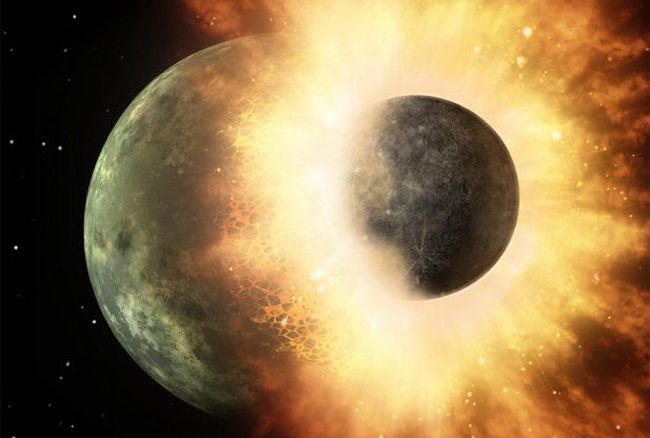
Scientists have found fresh evidence in lunar rocks showing that the moon was likely formed after a Mars-sized planet crashed into the proto-Earth more than 4 billion years ago.
A NASA-led team examined moon rocks brought back to Earth by Apollo astronauts more than 50 years ago. Investigating the samples with advanced tools not available to researchers in the 1960s and 1970s, the team found further evidence of the "giant impact theory" by focusing on the amount and type of chlorine in the rocks, a new study reports.
The researchers discovered the moon has a higher concentration of "heavy" chlorine compared to Earth, which sports more "light" chlorine. The terms "heavy" and "light" refer to versions of the chlorine atom, known as isotopes, that contain different numbers of neutrons in their nuclei.
Related: How the moon formed: 5 wild lunar theories
Shortly after the mammoth collision occurred, Earth was just able to stay together while pieces of both planets that were blasted into space coalesced to form the moon. Both of these blobby bodies had a mix of light and heavy chlorine isotopes at first, but that mix began to change as Earth's gravity pulled on the newly forming moon.
As the cosmic bodies continued taking new shape after the crash, Earth tugged away the lighter chlorine toward itself, leaving the harder-to-move heavy chlorine on the moon. This left the moon depleted of lighter chlorine compared to the heavier isotope.
"There’s a huge difference between the modern elemental makeup of the Earth and moon, and we wanted to know why," study co-author Justin Simon, a NASA planetary scientist, said in a statement. "Now, we know that the moon was very different from the start, and it's probably because of the 'giant impact' theory."
The scientists also checked their understanding by looking at other elements that are halogens, in the same chemical family as chlorine. Other "light" halogens are also less abundant on the moon, and the team could not see any pattern that would suggest a later event caused the loss.
The new study was published this month in the Proceedings of the National Academy of Sciences. It was led by Anthony Gargano, a graduate fellow at NASA's astromaterials research and exploration science division at the Johnson Space Center in Houston.
The research adds to a growing mountain of chemical evidence to support the giant impact hypothesis, which was first suggested decades ago. For example, a study released in March of this year used high-precision measurements of oxygen isotopes to show that Earth and moon rocks are probably even more different from each other than previously thought.
Follow Elizabeth Howell on Twitter @howellspace. Follow us on Twitter @Spacedotcom and on Facebook.
tinyurlis.gdu.nuclck.ruulvis.netshrtco.de
مقالات مشابه
- بارها به عقب باز در سا پس از سردرگمی
- Coronavirus گزارش ویژه: FDA معکوس در مبارزه با مواد مخدر تهمت تبلیغ
- چگونه نزدیک شما می توانید به یک سیاه چاله می شود ؟
- کسب و کار پر رونق می خواهید؟ روی محصولات بادی اینتکس تمرکز کنید!
- تصاویر از فضا! تصویر ما از روز
- آخرین coronavirus امداد لایحه به نظر می رسد برای افزایش کنگره فناوری قابلیت
- شرکت صادرات و واردات کالاهای مختلف از جمله کاشی و سرامیک و ارائه دهنده خدمات ترانزیت و بارگیری دریایی و ریلی و ترخیص کالا برای کشورهای مختلف از جمله روسیه و کشورهای حوزه cis و سایر نقاط جهان - بازرگانی علی قانعی
- شرکت صادرات و واردات کالاهای مختلف از جمله کاشی و سرامیک و ارائه دهنده خدمات ترانزیت و بارگیری دریایی و ریلی و ترخیص کالا برای کشورهای مختلف از جمله روسیه و کشورهای حوزه cis و سایر نقاط جهان - بازرگانی علی قانعی
- چگونه عسل طبیعی را از تقلبی تشخیص دهیم + چند راه مطمئن
- چین به تعویق انداختن راه اندازی Beidou ماهواره ای ناوبری جهانی